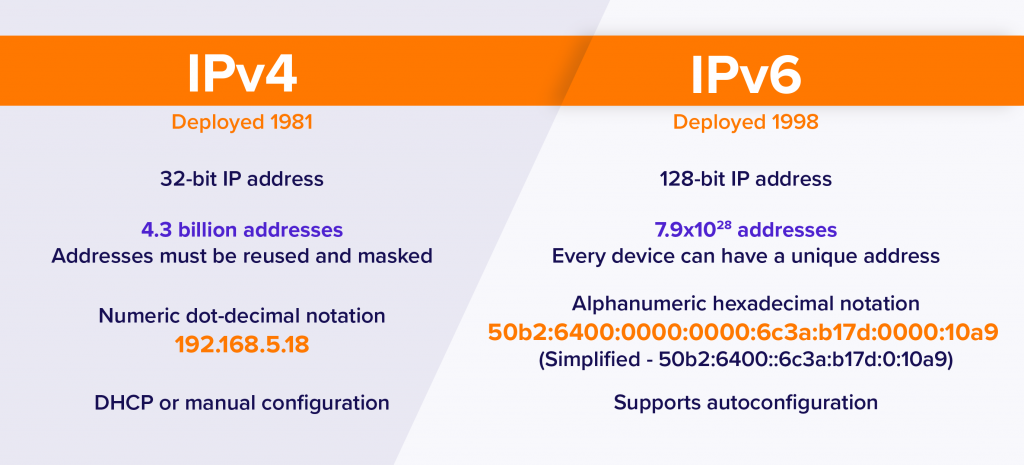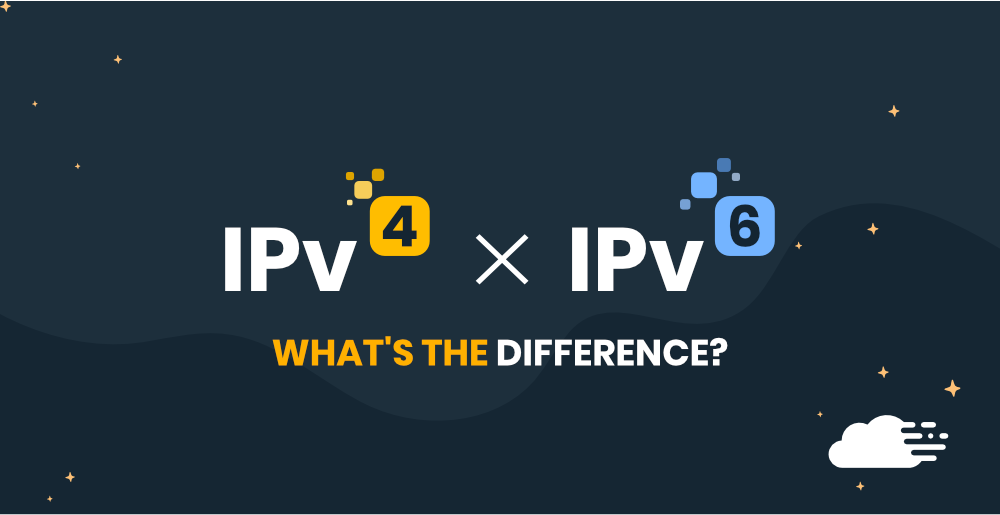What is IP? what is IPv4 or IPv6?
What is IP; Types of IP and its uses
An IP address (IP address) is a unique identifier assigned to any equipment connected to the Internet (or other networks based on the Internet Protocol) that can communicate with that equipment. Without an IP address, no computer, router, phone, or other device can connect because there is no identity or address to identify and communicate with. In addition, the IP address provides valuable information about these devices, including the data’s geographic location, the host company’s name (on certain websites), and…
(List of IP version numbers
Packets carrying Internet Protocol data have a 4-bit IP version number as their first header field. Currently, only IPv4 and IPv6 packets are seen on the Internet, which has IPs 4 and 6, respectively.)
IP address and its use on the Internet
One of the most essential communication protocols on which the Internet works is the Internet Protocol or Internet Protocol, called IP. This protocol is part of the necessary and integrated TCP/IP protocol. In addition to the Internet, most local networks worldwide also use this protocol in their communications.
The work of Internet Protocol is to:
They carry data packets from source to destination, but how do these protocols and network routers determine the origin and destination? The key to solving this problem is the address, the Internet Protocol address or IP address for short.
Every packet exchanged on the Internet has both a source IP address and a destination IP address. These IP addresses indicate where it comes from and where it should go. Every computer or other device connected to the Internet must have a valid IP address and be identified. Otherwise, the action can’t connect to the Internet, so it can’t send or receive.
______________________________________________________________________________________________________________________________________________
Internet protocol version 4
What does Internet Protocol version 4 mean?
Internet Protocol Version 4 (IPv4) is the fourth edition of the Internet Protocol and a widely used protocol in data communication in various types of networks. IPv4 is a connectionless protocol in packet-switching layer networks such as Ethernet. It provides a logical connection between network devices by providing an identifier for each device. There are many ways to configure IPv4 with various instruments – including manual and automatic settings – depending on the type of network.
IPv4 is based on a best-effort model. This model guarantees neither delivery nor avoidance of duplicate delivery. These aspects are handled by upper-layer transport.
IPv4 is defined and specified in the IETF publication RFC 791. It is used in the link layer of the packet switch in the OSI model.
IPv4 uses 32-bit addresses for Ethernet communications in five classes: A, B, C, D, and E. Classes A, B, and C have different bit lengths for addressing network hosts. Class D addresses are reserved for multicast, while Class E addresses are reserved for future use.
Class A has a subnet mask of 255.0.0.0 or /8, B has a subnet mask of 255.255.0.0 or /16, and class C has a subnet mask of 255.255.255.0 or /24. For example, with a subnet mask of /16, network 192.168.0.0 might use the address range 192.168.0.0 to 192.168.255.255. Network hosts can take any address from this range. But the address 192.168.255.255 is reserved for broadcasting on the network. The maximum number of IPv4 host addresses it can assign to end users is 232.
IPv6 provides a standard solution to overcome the limitations of IPv4. Because of the 128-bit address length, it can define up to 2128 addresses.

Internet protocol version 6
What does Internet Protocol version 6 mean?
Internet Protocol Version 6 (IPv6) is an Internet Protocol (IP) used to carry data in packets from a source to a destination across different networks. IPv6 is an advanced version of IPv4 and can support a much larger number of nodes than IPv4. It allows for 2128 possible node or address combinations.
IPv6 is also known as Internet Protocol Next Generation (IPng).
Techopedia describes Internet Protocol version 6
Released on June 6, 2012, IPv6 was developed in hexadecimal format and contained eight octets to providexcellentat scalability. Like IPv4, IPv6 deals with address broadcasting without having broadcast addresses per class.
What is meant by static and dynamic IP addresses?
One of thessentialnt categories of IP addresses is whether they are static or dynamic. But what is meant by static IP address and inactive IP address?
Static or fixed IP address
If a user receives a static IP address from his ISP, this address will always remain constant and will not change. Restarting or turning the computer and router on and off does not change the static IP address. Static IP addresses should be requested from your ISP. All IP addresses can be considered dynamic by default. These addresses are stored in a virtual repository called the IP repository. When a user requests a fixed or static IP, an IP is subtracted from the pool of dynamic IPs and assigned to him. For this reason, the ISP company usually charges an additional fee for providing a static IP address.
Most users, including home and business users and even organizations, usually do not need a fixed or static IP. But web-related businesses (such as web hosting, FTP servers, email servers, and VPN servers) and those whose services are based on geolocation prefer static IPs.
Advantages of the static IP address
Because a static IP does not change, it is very suitable for businesses that rely on IP addresses.
The provision of services based on geographic location (geolocation) is facilitated by using fixed IP because the geographic location can be identified from the IP address.
Dynamic or variable IP address
A variable or dynamic IP address can be continuously changed. Whenever a user connects to the Internet, the ISP company randomly selects one of the IP addresses in the IP pool and assigns it to him. However, the dynamic address of users may not change for days and maybe months, but this does not mean that their IP address is static. Most users are currently connected to the Internet with dynamic IP. When users get an Internet subscription from an ISP, their IP address is active by default. Changing the IP address has no adverse effect on the user’s daily work, and the user does not even notice that his IP address has changed (unless he has configured the computer equipment or network based on a fixed IP address). A dynamic IP address is a better option for most users because it is cheaper and has no disadvantages.
Advantages of the dynamic IP address
- It is cheaper
- Requires less setup and maintenance
- Dynamic IP is more secure than static IP.
What is a public IP address and a private IP address?
A public IP address is assigned to every device connected to the Internet, which can therefore be accessed from the Internet. When you connect to the Internet with a computer, phone, or any other device, a unique IP address is assigned to that device, called a public IP address. No two devices with the same public IP address can be found on the Internet.
Private IP addresses are reserved for private networks not connected to the Internet. Personal IP addresses are not used on the Internet.
A person with a home network (let’s say A) consisting of several computers assigns each of them a private IP address to communicate with each other. Someone else in the same city or elsewhere may have created another private network (for example, B) whose nodes’ addresses are similar to those of “A” network. But because these two networks are not connected or connected to the Internet, there is no problem with the similarity of their addresses. Thousands of private networks worldwide can use the same personal IP addresses. But if these networks want to connect to the Internet, they must convert their address into a unique public discourse in a particular way. For this purpose, a feature called “Network Address Translation” is used, also called NAT (abbreviation of Network Address Translation).
Because the number of IPv4 IP addresses is minimal compared to the population of Internet users, and it is impossible to assign a unique public IP to each Internet user, this problem can be solved using Network Address Translation (NAT) to the public addresses.
Private IP addresses have a specific domain:
IP address reserved
The Internet Engineering Task Force (IETF) and the Internet Assigned Numbers Authority (IANA) have reserved several IP addresses. These addresses are reserved for particular uses. In the following, some reserved IP addresses are briefly explained.
What is the IP range?
IP address range defines the range of allowed and valid IP addresses. In IPv4 format, the content of IP addresses starts from 000.000.000.000 and ends with 255.255.255.255. So, for example, the IP address 10.0.0.0 is valid, but the IP address 300.0.0.0 is invalid because it is outside the allowed range of IP addresses. In addition, depending on different applications, other domains can be defined. For example, in explaining public and private IP addresses, it was said that each has a specific part or range. IP address classes are other cases that each have their environment. But what are IP address classes, and what are their uses?
_________________________________________________________________________________________________________________________
In other way to say about:
IPV6 configuration guide on Windows for advanced users
Article
Windows Vista, Windows Server 2008, and later versions of Windows implement RFC 3484 and use a prefix table to determine which address to use when multiple addresses are available for a Domain Name System (DNS) name.
By default, Windows prefers IPv6 global unicast addresses to IPv4 addresses.
Summary
It is common for IT administrators to disable IPv6 to troubleshoot network-related problems such as name resolution problems.
Important
Internet Protocol Version 6 (IPv6) is mandatory for Windows Vista, Windows Server 2008, and newer versions. We do not recommend disabling IPv6 or its components. If you do this, some Windows components may not work.
We recommend using IPv4 to IPv6 preference instead of disabling IPv6 in prefix policies.
Use the registry key to configure IPv6
Follow the steps in this section carefully
If you modify the registry incorrectly, serious problems can occur. Before you change it, make a backup copy of the registry if something goes wrong.
IPv6 functionality can be configured by changing the following registry key:
- Location: HKEY_LOCAL_MACHINE\SYSTEM\CurrentControlSet\Services\Tcpip6\Parameters\
- Name: DisabledComponents
- Type: REG_DWORD
- Minimum value: 0x00 (default value)
- Maximum value: 0xFF (IPv6 disabled)
_________________________________________________________________________________________________________________________
List of IP version numbers in Wikipedia:
Packets that hold Internet Protocol data carry a 4-bit IP version number as the first field of its header. Currently, only IPv4 and IPv6 packets are seen on the Internet, having IP version numbers 4 and 6, respectively.












